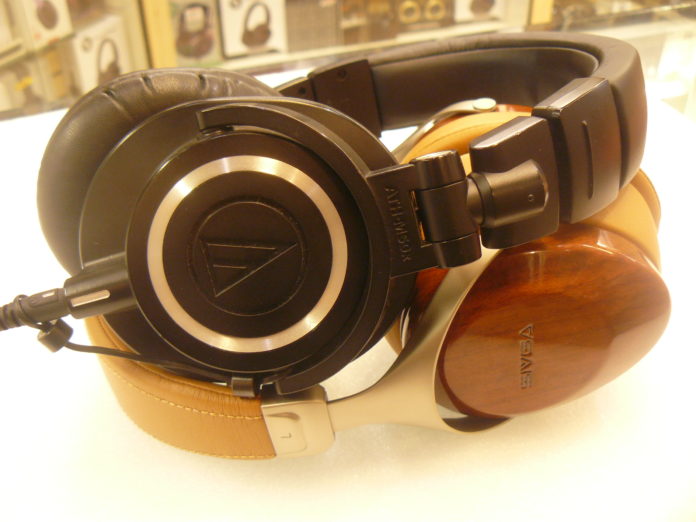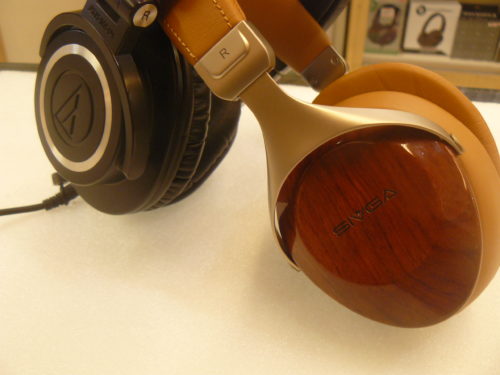In 2021 we’ve seen very few new over-ear headphones released. That’s why I was ecstatic when SIVGA recently announced and launched the SV021. Listening to these new headphones gave me a nice break from all the IEMs and true wireless headphones, and I enjoyed them quite a bit. There’s a bit of competition though, and at this price range, a lesser known brand like SIVGA can be a tough sell. Definitely one of the most notable headphones in this price range is the Audio Technica M50x. It’s become a staple for critical listeners not looking to spend an excessive amount of money on headphones. Naturally, the SV021 is now a sort of rival, being available for the exact same price. Can the SV021 stack up against the behemoth that is the M50x?
Look and Feel
In regards to appearance, this is a tale of two completely different headphones. For starters, the M50x has always had this bulky, plastic look. However, over the years, Audio-Technica has proven this to be a versatile build, coating the headphones in a variety of colors with limited edition runs. Otherwise, the main black and white versions of the M50x have a mechanical look that have stood up for years.
Although they sport a classic design, the M50x just doesn’t hold a tea when up against the build of the SV021. SIVGA is almost masterful with its specialty wooden cup builds, and the SV021 is one of their most striking to date. It uses a combination of rosewood with a glossy resin finish, and a metal yoke for support. The materials and craftsmanship on display here, far outdoes the M50x, or any over-ear headphone for that matter in this price range.
The fit is somewhat less of a steal for the SV021. While they’re both perfectly comfortable headphones, they both sport different types of fit. Both the M50x and SV021 should last you many non-fatiguing hours, but I found the SV021 to be a much looser fit than the M50x. The M50x has a much tighter grip around your ears, and offers a bit more support when moving your head around. However, the SV021 allows a bit more airflow for a more breathable fit.
Design
Both of these headphones feature similar components that make up its main driver system. Its main difference is in its size. The SV021 features a 40mm driver, while the M50x goes a bit higher than that with a 45mm driver. They’re both dynamic units, with copper clad- aluminum wire voice coils. The SV021 has an ultra-thin diaphragm and uses 3mm magnets. While the M50x also uses magnets, its size is not stated.
Soundstage
SIVGA and Audio-Technica are both very reliable when it comes to getting a good soundstage. These are two very different headphones with different purposes, and that’s reflected in each headphones quality of imaging. When I first heard the SV021, I was blown away by its grand soundstage. It excels in providing an ample amount of separation and layering for a closed-back headphone. They deliver a great amount of depth that quickly immerses you in its sound field, with instruments and effects coming off as airy and distant, like the sounds are originating from a proper source.
With the M50x, you’re getting a quite different experience. While the SV021 aims for a much more exaggerated soundstage, the M50x keeps things tight and accurate. Positioning is much more forward, placing on the elements on a more equal sound field. This accomplishes a much more transparent stereo image in response, where sounds are easier to decipher for more analysis rather than immersion.
Low End
This is a tough one, because both the M50x and SV021 have very strong bass responses. Both headphones contain a deep and punchy bass that extends through the mix and creates a grander sound signature with a significant impact that immediately makes an impression. Where these headphones start to diverge is in their tonality. The M50x is a lot more neutral here than the SV021. They both provide a deep rumble, but the SV021 is able to extend itself a bit more through the sound signature. The M50x leans more towards a boomier tone that has the ability to cloud the mix. In comparison, I think the SV021 is a lot more clean in its low-end response.
Mids
In the midrange, the M50x and SV021 throw different accents on certain bands of frequency. For instance, the low-mids of the SV021 are slightly more emphasized than the M50x, creating a warmer timbre. However, there’s much better balance in the M50x that makes it more even across all frequencies. It’s the more accurate headphone, but the SV021 definitely adds more coloration here, with extension in the upper-mids. It almost mimics a v-shaped timbre, but I wouldn’t call the mids on in the SV021 recessed at all. No matter what, there’s no complication with the midrange of the M50x. The timbre presents everything transparently, and with maximum clarity.
Highs
The treble is what’s going to make it or break it for some listeners. For me personally, I prefer a more present high-end, with sibilance and slight brightness. The SV021 delivers what I’m looking for in droves, but I understand that type of sound isn’t for everyone. You’ll find much more balance from the M50x here, presenting the frequencies with a much more digestible response. That’s not to say the M50x doesn’t contain its fair share of brightness. This timbre have some slight sharpness in small bands of frequency, with some sibilance. However, it’s nowhere near as extensive as the SV021, which just coats the sound signature in a layer of bright texture across the board.
Summary
Overall, both the SIVGA SV021 and the Audio Technica M50x have their purposes. While the SV021 brings that colorful, blissful sound signature, the M50x focuses on balance and transparency. I think the M50x will still be the king of the budget mixing headphone, but the SV021 is awesome for just and enjoyable, immersive listening experience. For $149, you can’t go wrong with either.
The SIVGA SV021 and Audio Technica – ATH-M50x are available at Audio 46.
Compare the ranking of various headphones, earbuds and in-ear monitors using our tools.
Discuss this, and much more, over on our forum.
---MAJORHIFI may receive commissions from retail offers.

















